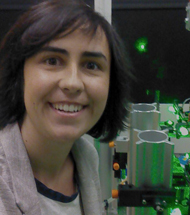Chemistry + Physics: the degree program of Celia
Celia Lozano tells from the high school Max Planck in Stuttgart how she has managed to unite Chemistry and Physics in a leading research

PHOTO: Courtesy
Celia Lozano (Chemistry 2010, PhD Physics 2014) made the leap from her Degree at Chemistry to Physics thanks to the doctorate that made the department of Physics and Applied Mathematics of the School of Sciences. Now, at the Max-Planck-Institute in Stuttgart - one of the most prestigious research centers in the world - he has managed to assemble the knowledge of both sciences with the design of self-directed micronaders.
This finding, with applications in the controlled release of drugs or in the manufacture of "smart" Materials , has earned her and her team the publication of a paper in Nature Communications.
- What was the topic of your doctorate?
When I finished the degree program I decided to make a change and I did the doctorate in the department of Physics and Applied Mathematics, with the doctoral program in Complex Systems. The topic was the analysis of the factors that include in the durability of jams.
It is enough to take a look around us to realize the multitude of systems that can become clogged: from grains of salt in a salt shaker, to a group of people trying to enter the place of bulls or cells occluding in the bloodstream. This clogging is due to the training of a stable structure upstream of the outflow, called an arch, which stops the flow of material.
Although jamming is a widespread problem, prior to this thesis it was not known what the stability of arcs depended on. To study it experimentally at laboratory we use a paradigmatic case: the granular subject . A granular medium is a collection of finely divided solids that interact with each other only through contact forces, such as seeds or sand.
The most important result of my thesis was finding that the durability of the jams depends on the shape of the arc. A thorough analysis revealed that the determining factor for breakage is the angle between each arc particle and its two neighbors. The larger the angle, the more easily the arc will break and, therefore, the less stable the jam will be.
- How did you get the postdoc at high school Max Planck?
When I was going to finish the thesis I had different offers to do the Postdoc in topics related to my thesis . But I wanted to change topic. One of my directors, Dr. Iker Zuriguel, coincided in one lecture with my current boss, Prof. Clemens Bechinger, and wrote me an email saying: 'Look at this group, I think you would fit perfectly'. I looked him up and what attracted me to him was the perfect combination of my licentiate degree in Chemistry and my PhD in Physics. Also, at group they were working on very novel research topics, had quite a few publications in high impact journals and a lot of money for research. So I sent an email to my current boss and the next day he was already conducting a Skype interview. He invited me to go to the Max-Planck-Institute in Stuttgart to give a talk and meet group, and the same day of the visit he offered me a place for 3 years.
- What is your current topic from research?
It is Phototaxis: the ability to move towards or away from light sources. It is an essential characteristic of many microorganisms, such as bacteria or motile cells. For example, the marine phytoplankton, manager original of the presence of oxygen (O2) in the atmosphere. Phytoplankton has a phototactic behavior that allows it to use solar energy efficiently for its metabolism or, conversely, protects it from excessive light intensity.
In contrast to living systems, where this is achieved by very complex internal machinery, the challenge is applied to synthetic microswimmers. At Clemens Bechinger's group we have endowed synthetically produced particles with a motility system that is activated by light. The microswimmers have a surprisingly simple design : transparent glass beads measuring a few thousandths of a millimeter in diameter that are partially covered by a light-absorbing material, e.g., cabon.
These particles themselves can "sense" environmental differences and, as a consequence, can self-orient themselves as if they were compasses. Thus, depending on the environmental conditions, our micronadators are able to direct themselves autonomously according to the conditions we impose on them. In our case, opting for the dark.
- How did you receive the news of the publication in none other than Nature Communications*?
I have to say that what gave me the most joy was the finding of the effect, and seeing how general it was for other systems. At that moment, both my collaborators and I realized that we had a chance to publish in a high-impact journal. In addition, the publication of a article always gives joy, as it indicates that the academic community accepts that work as relevant.
- What practical application/applications could the results of your research have?
The employee system is very simple. It will make it possible to create millions of microneedles that, being able to direct themselves, will open up new lines of research: from the manufacture of materials in a more intelligent way, to the field of drug delivery, etcetera.
- At this moment of "success" in your work, how do you see the future after the postdoc?
I am often asked this question lately. I haven't decided yet. I really like both research and teaching, but in our degree program it is difficult to achieve stability. In fact, it is usual to link one PosDoc with another, and try to get some junior place . I also do not rule out returning to Spain, although the current conditions do not seem to be the most favorable.
